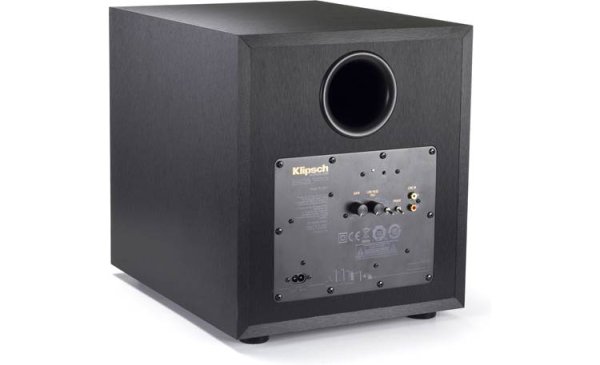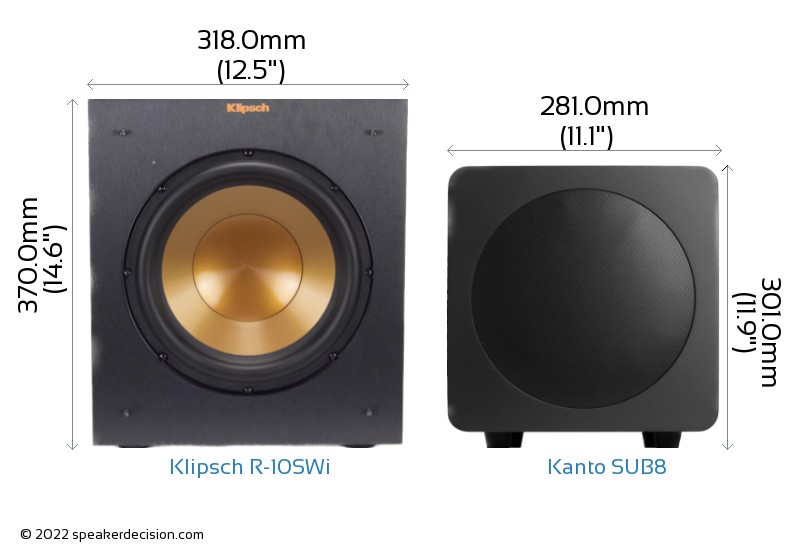In this review, we will be comparing R-10SWi and SUB8, two Powered Subwoofer speakers from Klipsch and Kanto. Being Powered subwoofers, they both have built-in amplifiers so you don't need an external power amp or an integrated amp to power them. Let's have a brief look at the main features of Klipsch R-10SWi and Kanto SUB8 first before getting into our more detailed comparison.
In the following sections, we will get into details in order to better understand how the Klipsch R-10SWi and Kanto SUB8 compare and hopefully end up with enough arguments to decide which one of these subwoofers is the better choice for you.
**This post contains affiliate links, and I will be compensated if you make a purchase after clicking through my links. As an Amazon Associate I earn from qualifying purchases.
Drivers
The efficiency of a subwoofer is directly proportional to the total radiating are squared hence the woofer quantity and diameter.Both Klipsch R-10SWiand Kanto SUB8 have a single woofer setup however the Klipsch R-10SWi's woofer is 10-inch whereas the Kanto SUB8 features a 8-inch woofer.
Frequency Response
R-10SWi has a frequency range of 32-120 Hz whereas SUB8 has a frequency range of 35-175 Hz. With a minimum frequency of 32Hz, the R-10SWi can go slightly deeper then the SUB8's min frequency of 35Hz.
Below graphs depict how these two speakers compare with the max, min and average values of the Min and Max Frequencies of other speakers in the Subwoofer class in our database.
Low Frequency
Subwoofer Speakers
High Frequency
Subwoofer Speakers
Cabinet Type
The Klipsch R-10SWi has a Bass Reflex type cabinet. Bass Reflex type subwoofers (aka Ported, Vented or Reflex Port) have enclosures that uses a port, hole or vent cut into the cabinet. Ported designs are generally more efficient than the Sealed designs. On the other hand the Kanto SUB8 have Acoustic Suspension type enclosure. Acoustic Suspension aka Sealed type subwoofers have enclosures that are sealed hence no ports or holes exists on the cabinet. Sealed designs helps to provide more accurate and tight bass responses compared to ported designs.
 Klipsch R-10SWi Port
Klipsch R-10SWi Port
Physical Specs
Size of a speaker can sometimes become an important decision factor due to space constraints or in some cases purely for esthetic reasons. In this section, we are going to compare Klipsch R-10SWi's and Kanto SUB8's external dimensions. Klipsch R-10SWi has external dimensions of 370.0 x 318.0 x 462.0mm ( 14-9/16 x 12-1/2 x 18-3/16inch) whereas Kanto SUB8 has external dimensions of 301.0 x 281.0 x 329.0mm ( 11-13/16 x 11-1/16 x 12-15/16inch) .
Klipsch R-10SWi is clearly the larger of the two speakers. Its body is 37mm wider, 69mm taller and 133mm deeper than Kanto SUB8.
Below you can see the front view size comparison of Klipsch R-10SWi and Kanto SUB8 in scale.
 Comparison image of Klipsch R-10SWi and Kanto SUB8 Size and External Dimensions
Comparison image of Klipsch R-10SWi and Kanto SUB8 Size and External Dimensions
Base Surface Area Comparison
Base surface area of a loudspeaker may become a determining factor when the space in your room or desk is limited.
The base surface area of the Klipsch R-10SWi is approximately 1469.2cm2 / 227.7inch2 and base area of the Kanto SUB8 is approximately 924.5cm2 / 143.3inch2. The R-10SWi requires 59% more surface area than the SUB8 which gives it a small disadvantage on placement in tight spaces.
Weight Comparison The weight of a subwoofer may become an important factor if you need to move and reposition the unit often to find the optimal positioning, also known as 'Subwoofer Crawling'. The Klipsch R-10SWi weighs 11.59kg / 25.5lbs and the Kanto SUB8 weighs 7.82kg / 17.2lbs. This makes the R-10SWi 48% heavier than the SUB8.
Here is a comparison of how R-10SWi and SUB8's weights compare with the average, max and min weights in Powered Subwoofer class.
Weight
All Subwoofer Speakers
What's in the Box of Klipsch R-10SWi?
Here are the items that are included inside the box of R-10SWi:
Powered subWireless transmitter (attached 12
What's in the Box of Kanto SUB8?
Here are the items that come with the SUB8:
Powered subwoofer6-feet AC power cord9.75-feet mono-RCA cableUser Manual
 Woofer Size Woofer Size |
10 inches
vs
8 inches
|
Larger woofer |
 Low Frequency Response Low Frequency Response |
32 Hz
vs
35 Hz
|
Generates deeper bass |
 Price per pair* Price per pair* |
274USD
vs
300USD
|
costs less (*prices may change depending on the seller, location and time) |
 Wireless Operation Wireless Operation |
Yes
vs
No
|
Connect your subwoofer to your system wireless |
 High Frequency Response High Frequency Response |
175k Hz
vs
120k Hz
|
Generates higher frequency |
 Port Position Port Position |
Front
vs
Rear
|
Gives more flexibility placing close to walls |
 Height Height |
301mm
vs
370mm
|
Easier to fit in smaller spaces |
 Base Surface Area Base Surface Area |
924cm2
vs
1469cm2
|
Takes less floor space |
| General |
Klipsch Reference R-10SWi |
Kanto SUB8 |
| Brand |
Klipsch |
Kanto |
| Speaker Type |
Powered Subwoofer |
Powered Subwoofer |
| Max Amplifier Output |
150 watts |
125 watts |
| Frequency Response |
32-120 Hz |
35-175 Hz |
Amplifier |
|
|
| Watts RMS (Continuous) |
150-watt RMS |
125-watt RMS |
| Watts Peak (Max) |
300-watt RMS |
250-watt RMS |
Drivers |
|
|
| Woofer Quantity |
1 |
1 |
| Woofer Size |
10" |
8" |
| Woofer Composition |
Copper IMG |
Paper |
| Tweeter Size |
- |
- |
| Aimable Tweeter |
No |
No |
| Midrange Driver |
No |
No |
| Firing Direction |
rear |
front |
Physical Specs |
|
|
| Height |
370.0mm (14.6") |
301.0mm (11.9") |
| Width |
318.0mm (12.5") |
281.0mm (11.1") |
| Depth |
462.0mm (18.2") |
329.0mm (13") |
| Weight |
11.59kg (25.5lbs) |
7.82kg (17.2lbs) |
| Enclosure |
Bass Reflex |
Acoustic Suspension |
| Grille |
Yes |
n/a |
| Moisture Resistancy |
No |
No |
Connections |
|
|
Other |
|
|
| Parts Warranty |
2 Years |
2 Years |
| Labor Warranty |
2 Years |
2 Years |